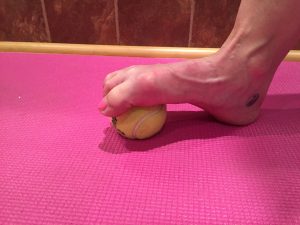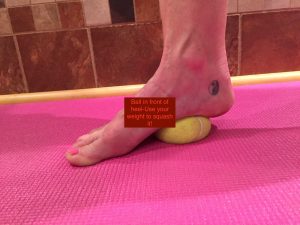In my last post, I discussed the various ways we abuse our feet with ill-fitting shoes. This time, I want to share my favorite way to improve the health of your feet, even if you insist on stuffing them into pointy high heels. But don’t do that, k?
In every class I teach, we take 3-5 minutes nearly every week to enjoy a foot massage, with help from a tennis ball. A few of my students prefer a deep-tissue massage, if you will, and they use a smaller ball made of hard rubber or even a golf ball.
The purpose of the foot massage is to manipulate the structures and tissues of the foot in various ways that might mimic, at least in part, the myriad ways the foot is naturally designed to move. Our feet are fascinating wonders of architecture. Each foot contains 26 bones, 33 joints and more than 100 muscles, tendons and ligaments. There are also 3 distinct arches: the inner one we all know about; one on the outer (pinky) edge; and the transverse arch that runs across the ball of your foot. (Check them out: I’ll wait. But leave your shoes off.) The feet also provide a great deal of proprioception, which basically means they tell our brains where our body parts are in space and relative to each other. This is kind of important.
So why do we need to manipulate our tootsies with a tennis ball? In a word: shoes. Even shoes that fit well tend to restrict the movement of our feet somewhat, and most shoes provide so much support and protection—both arguably necessary in our modern environments—that the feet become weak and tight. Think about your typical day: even if you walk a lot (yay, you!), it is likely done on flat, level ground while wearing shoes. Some of my favorite yoga teachers have described shoes as “sensory deprivation chambers for our feet” and feet themselves as “off-road vehicles that are never taken off the road”.
So, grab a tennis ball and let’s get started.

